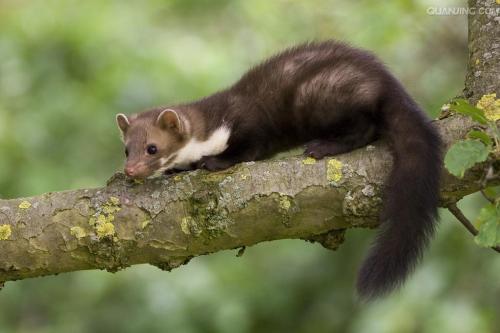Martes foina
IUCN
LCBasic Information
Scientific classification
- name:Martes foina
- Scientific Name:Stone marten, rock marten, snow-sweeping marten, beech marten, raccoon fox
- Outline:Carnivora
- Family:Carnivora Mustelidae Martes
Vital signs
- length:45cm
- Weight:1.5kg
- lifetime:18year
Feature
Distribution and Habitat
Stone martens are widely distributed in Eurasia, mainly in western and central Europe, including Afghanistan, Albania, Armenia, Austria, Azerbaijan, Belarus, Belgium, Bhutan, Bosnia and Herzegovina, Bulgaria, China, Croatia, Czech Republic, Denmark, Egypt, Estonia, France, Germany, Georgia, Greece, Hungary, India (northern), Iran, Islamic Republic, Iraq, Israel, Italy, Jordan, Kazakhstan, Kyrgyzstan, Latvia, Lithuania, Lebanon, Liechtenstein, Luxembourg, Macedonia, Former Yugoslav Republic, Moldova, Mongolia, Nepal, Montenegro, Pakistan, Poland, Portugal, Romania, Russia, Serbia, Slovakia, Slovenia, Spain, Switzerland, Syrian Arab Republic, Tajikistan, Turkey, Turkmenistan, Ukraine, Uzbekistan, etc. It once existed in the Netherlands, but may have disappeared. It was artificially introduced to Wisconsin, USA.
In China, it is mainly distributed in Shanxi, Hebei, Inner Mongolia, Sichuan, Ningxia, Shaanxi, Gansu, Qinghai, Yunnan, Xinjiang, Tibet and other places in the central and west
Appearance
The stone marten is slender and similar in size to the sable. It has a triangular head, a pointed snout, a narrow and long nose with a slightly concave center, erect and blunt ears, a stout body, short and thick limbs, with the hind limbs slightly longer than the forelimbs, and fur-covered soles. Both the forelimbs and hindlimbs have five toes, which are short and slightly webbed. It walks on its toes, has five toe pads, three palm pads, sharp and curved claws, and can partially retract.
The fur color is a single gray-brown or light brown, with abundant underfur, white or light yellow, sparse guard hair, dark brown or light brown, and cannot cover the underfur; the head is light gray-brown, the ear edge is white, and the throat and chest have a distinct white or cocoon yellow patch (also known as marten crop), which is "V" shaped or irregularly ringed, and some patches are long strips in the center of the throat and chest; because the guard hair is short and dense, the gua
Details
The stone marten is a small to medium-sized mammal of the genus Marten, and is relatively small among its close relatives.

The stone marten is territorial, and most of them live alone except during the breeding and lactation period; the male nesting area overlaps with the nesting areas of multiple females. The nest area of individuals in forest habitats is the largest. In the era when hunting was less common in Europe, the nest area of individuals in rural areas and villages was 9.5 to 880 hectares, with an average of 37 to 49 hectares (females) and 111 to 113 hectares (males).
Stone martens are bold and brave. When males and females move in pairs, they often return to their original places to search after they disperse. They have sharp hearing and vision. When they hear a sound, they will immediately crawl on the ground, listen and peek in the direction of the sound. During the mating season in July every year, they make a long and short "Wow, oh..." call to court each other. The short sound is high and loud, and the long sound is a throat sound that goes from high to low and has a slight tremor. Usually, except for mating and lactation, they live alone and do not have fixed caves.
Stone martens are very rare in China, and are on the verge of extinction in many areas and are difficult to see. According to field surveys, it is preliminarily estimated that there are still 4,000 to 4,500 in eastern and southern Tibet. The population in Europe remains stable. Since the 1960s and 1970s, the stone marten population has increased in Central and Western Europe.
It is generally believed that overhunting and habitat destruction are the main reasons for the threat to stone martens; but considering that stone martens have a wide range of habitats, overhunting as a major fur animal for a long time may be the main reason. Stone martens have always been an important hunting target in China; in the early 1950s, the policy of strengthening resource protection, active breeding and feeding, and reasonable hunting and utilization was neglected, resulting in great damage to stone martens and the natural environment on which they depend for survival. They were hunted by people and their numbers dropped sharply.
In 1998, it was listed as a Class II protected animal in China's "National Key Protected Wildlife List", which came into effect upon approval by the State Council.
Listed as a "Vulnerable (V)" species in the "China Red List of Endangered Animals·Mammals".
Listed in the "China Red List of Species": Endangered (EN).
In 2008, the conservation level (globally) in the Red List of the World Conservation Union (IUCN) was Least Concern (LC).
The Central Asian subspecies of stone marten Martes foina intermedia (India) (commonly known as the northern subspecies of stone marten in China) is listed in Appendix III of the 2010 Convention on International Trade in Endangered Species of Wild Fauna and Flora (CITES).
Listed in the second level of the "List of National Key Protected Wildlife in China".
Protect wild animals and eliminate game.
Maintaining ecological balance is everyone's responsibility!








